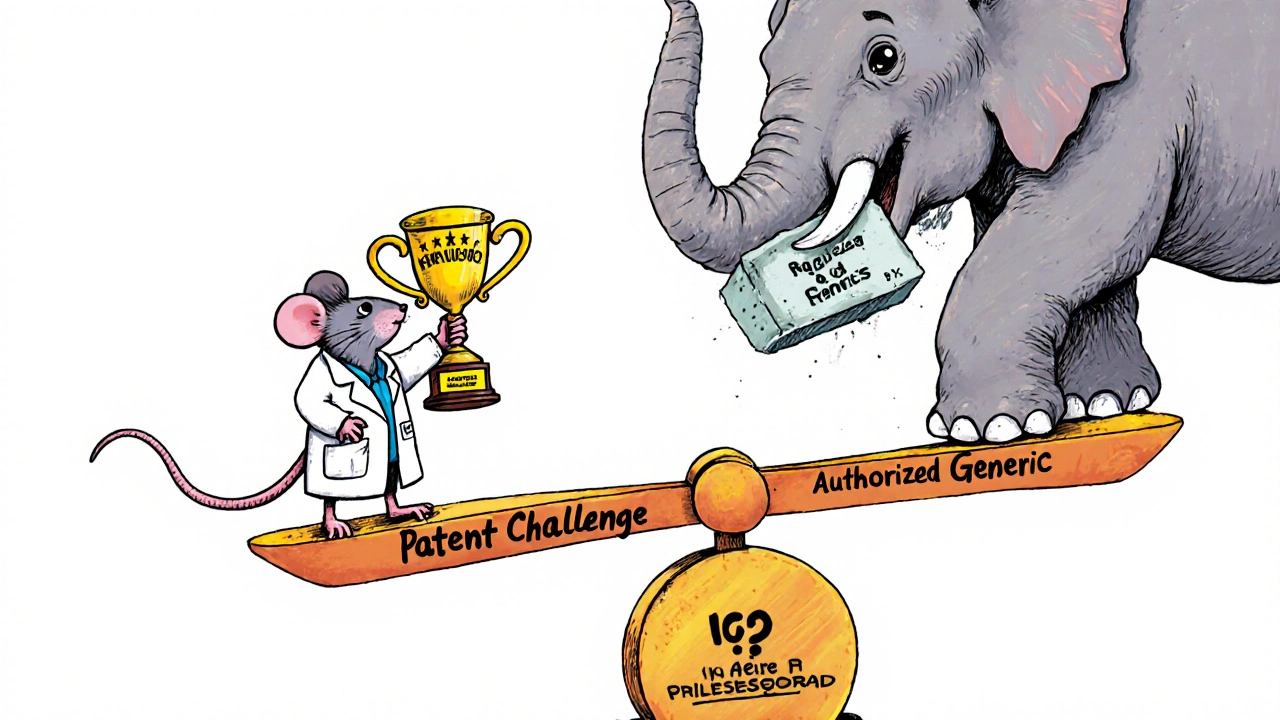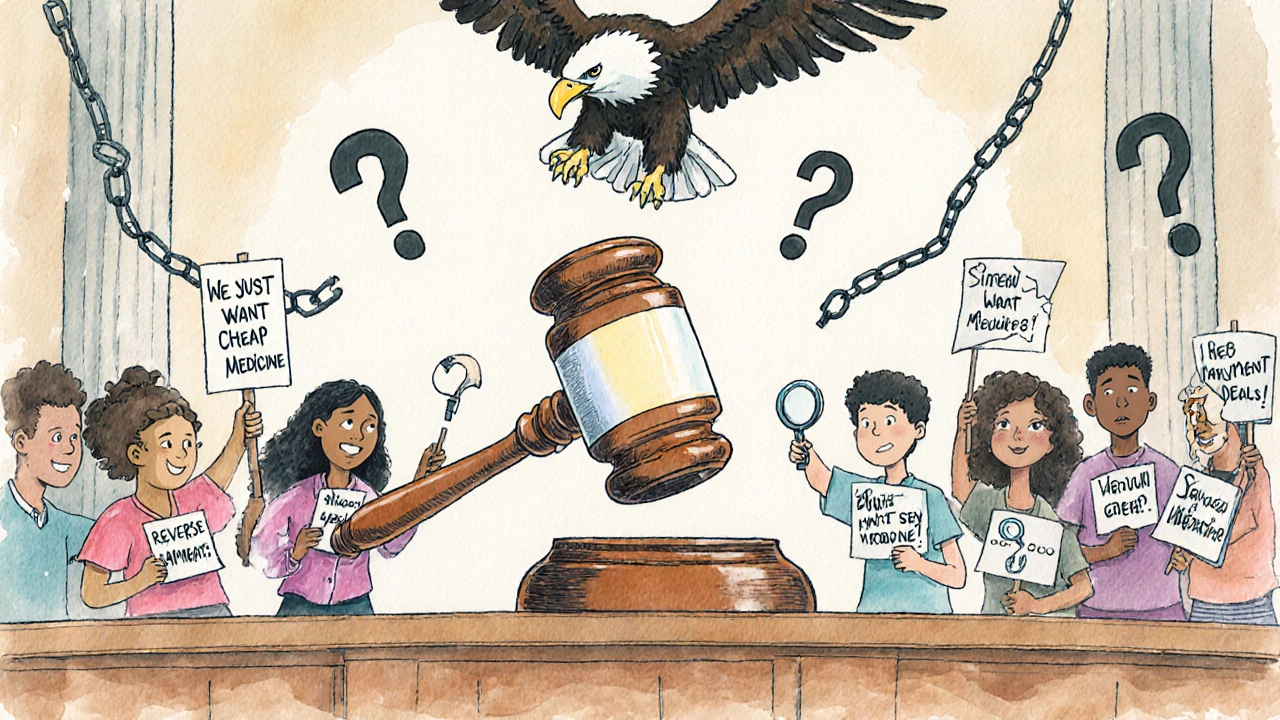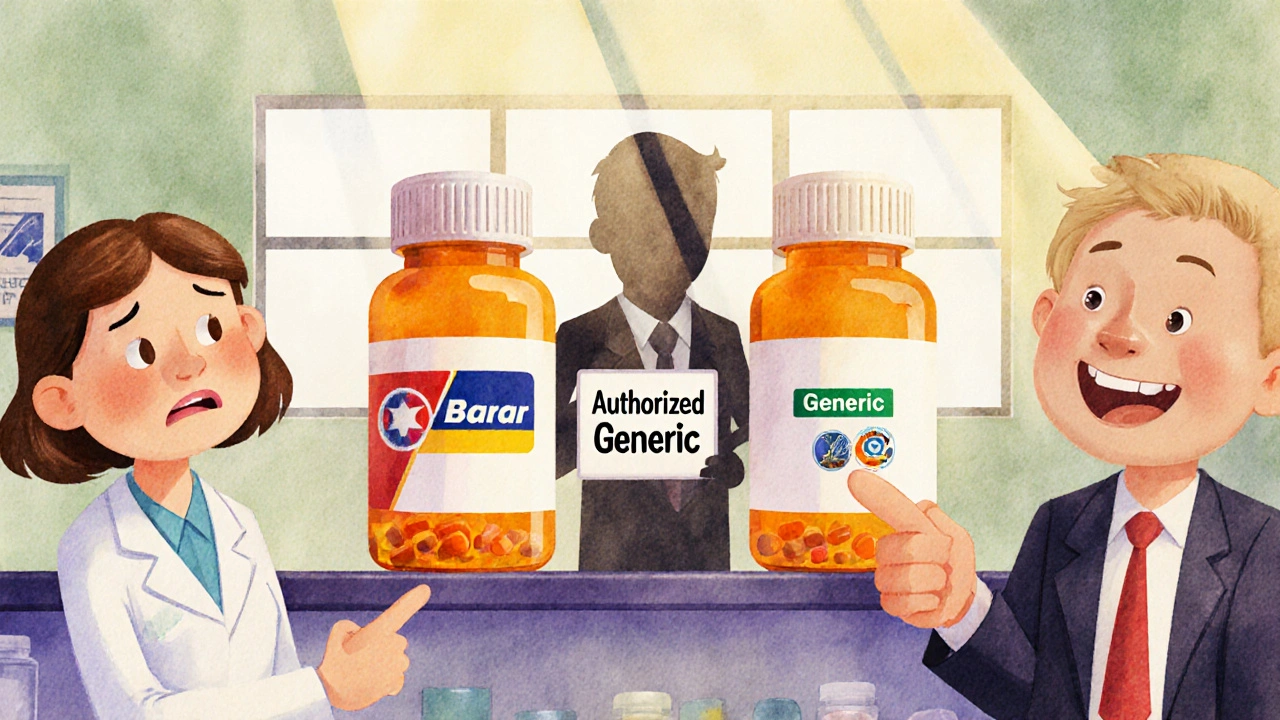When a brand-name drug’s patent runs out, the market should open up. Cheap generics flood in, prices drop, and patients save money. That’s the promise of the Hatch-Waxman Act-a 1984 law designed to balance innovation and access. But here’s the twist: sometimes, the brand-name company itself launches a generic version of its own drug. These are called authorized generics. And they don’t just compete with other generics. They change the whole game.
What Exactly Is an Authorized Generic?
An authorized generic is the exact same drug as the brand-name product-same active ingredient, same dose, same manufacturer-but sold under a generic label and usually at a lower price. It’s not a copy. It’s the real thing, just repackaged. The brand company doesn’t need new FDA approval because it’s already approved. All they do is slap a new label on it and ship it out. This isn’t some loophole. It’s legal. The FDA has said so since the early 2000s. But here’s the problem: it happens right when the first independent generic company is supposed to get a 180-day monopoly on selling the generic version. That exclusivity period was meant to reward the company that took the risk to challenge the patent in court. Instead, the brand company often drops in its own generic version just days after the first generic hits the shelves.How It Screws With Competition
Think of it like this: you’re the first person to open a coffee shop in a new neighborhood. You’ve got the whole market to yourself for six months. Then, the biggest coffee chain in town opens a second store-same beans, same brew, same price-right across the street. Only they’ve got more money, more customers, and a bigger logo. That’s what an authorized generic does. The Federal Trade Commission (FTC) studied this. When an authorized generic enters the market during the 180-day exclusivity window, it grabs 25-35% of sales. That doesn’t sound like much-but it’s enough to crush the first generic’s profits. Instead of capturing 80-90% of the generic market, that first company now gets maybe 40-50%. Revenue drops by 40-52% during that critical window. And the damage doesn’t stop there. In the three years after, those companies still make 53-62% less than they would have without an authorized generic. Why? Because the authorized generic isn’t priced like a true generic. It’s cheaper than the brand, but not nearly as cheap as the independent generic. So pharmacies and insurers end up buying the authorized version instead of the cheaper one. The real competition never gets a chance to take off.The Secret Deals: Reverse Payments and Silent Agreements
Here’s where it gets shady. Between 2004 and 2010, about 25% of patent settlement deals between brand and generic companies included a hidden promise: the brand won’t launch an authorized generic if the generic company delays its market entry. These are called “reverse payments”-because the brand pays the generic to stay out of the market. The FTC calls these the most egregious form of anti-competitive behavior in pharma. And they’re not rare. One study found these deals delayed generic entry by nearly 38 months on average. That’s over three years of monopoly pricing for a drug that was supposed to become cheap. Even worse? The brand doesn’t even have to pay cash. Sometimes, they just promise not to launch an authorized generic. That’s enough to convince a generic company to sit on its hands. The generic gets a guaranteed profit. The brand keeps its market share. Patients pay more.
Who Benefits? Who Loses?
Let’s break it down. Branded drug companies win. They keep control. They avoid the full price drop. They even get to profit from the generic version they never stopped making. Independent generic manufacturers lose big. Teva Pharmaceutical reported a $275 million revenue drop in 2018 from just one authorized generic. Smaller generics? They can’t survive that kind of hit. Many just stop filing patent challenges altogether. Patients and insurers pay more. The authorized generic keeps prices higher than they should be. Even though it’s labeled “generic,” it doesn’t bring the price down like a true competitor would. Pharmacies and pharmacy benefit managers (PBMs) sometimes prefer authorized generics because they’re more reliable and come with brand-name backing-but that doesn’t mean it’s cheaper for patients. The public loses too. If generic companies stop challenging patents because they know a brand will crush them with an authorized version, fewer generics ever come to market. That means fewer price drops. And fewer savings.Why This Still Happens-And Why It Might Be Changing
The Hatch-Waxman Act never said anything about authorized generics. That silence created a loophole. Courts have allowed it. The FDA hasn’t blocked it. So companies kept doing it. But things are shifting. Since 2020, the FTC has opened 17 investigations into authorized generic arrangements. In 2022, the agency made it clear: “We will challenge any arrangement that uses authorized generics to circumvent the competitive structure Congress established.” Legislation is catching up, too. In March 2023, Senators Klobuchar and Grassley reintroduced the Preserve Access to Affordable Generics and Biosimilars Act, which would ban deals that delay authorized generic entry. It’s not law yet-but the pressure is real. And companies are responding. A 2023 study found that authorized generics are now less likely to enter the market after a patent settlement than they were in 2010. In 2010, 42% of eligible markets got an authorized generic. By 2022, that number dropped to 28%. Companies are learning that the legal and political cost is rising.
The Bigger Picture: Innovation vs. Access
The pharmaceutical industry argues that authorized generics increase competition by adding supply. They point to a 2024 Health Affairs study that says on-invoice prices for pharmacies were 13-18% lower when an authorized generic was available. That’s true-but it misses the point. The real competition comes from independent generics, not the brand’s own product. The authorized generic doesn’t drive prices down-it holds them in place. The Congressional Research Service found something else: for drugs with low sales-under $27 million a year-authorized generics make it less likely that any generic company will challenge the patent at all. Why risk a $50 million lawsuit if you know the brand will just undercut you with its own version? That’s a death sentence for competition on cheaper drugs.What’s Next?
The system is still broken. Authorized generics are legal. But they’re not fair. They turn a law meant to promote competition into a tool for extending monopolies. Right now, the FTC is watching. Courts are watching. Congress is watching. And more generic companies are choosing to fight back in court instead of settling quietly. If you’re a patient, ask your pharmacist: Is this drug an authorized generic? If it is, it might not be the cheapest option-even though it says “generic” on the bottle. If you’re a policymaker, the fix is clear: ban reverse payments that delay authorized generic entry. Close the loophole. Let real competition work. The goal isn’t to punish brands. It’s to make sure the system works the way Congress intended: when a patent expires, the market opens. Not just for one player. For everyone.Are authorized generics the same as regular generics?
Yes, in every way that matters-same active ingredient, same manufacturer, same dosage. The only difference is the label. Authorized generics are made by the brand-name company and sold under a generic name. Regular generics are made by independent companies that reverse-engineered the drug and got FDA approval.
Why do brand companies launch authorized generics?
To protect their profits. Instead of letting an independent generic company capture 80-90% of the market, the brand company enters the market itself with a lower-priced version. It captures a big chunk of sales and keeps the price from dropping too far. It’s a way to maintain control without breaking the law.
Do authorized generics lower drug prices for patients?
Sometimes, but not always. Authorized generics are cheaper than the brand-name version, but they’re usually more expensive than true generics. Because they’re priced higher than independent generics, they prevent the full price drop that comes from real competition. Patients often end up paying more than they would if the market had a true first-filer generic.
Can generic companies still challenge patents if authorized generics exist?
Yes-but it’s harder. The financial risk is much higher. If a generic company wins the patent challenge, the brand might still launch an authorized generic and cut their profits by half. For smaller generic companies, that risk makes it unprofitable to challenge patents on drugs with low sales. So fewer challenges happen overall.
Is the FDA trying to stop authorized generics?
No. The FDA allows them because they’re not new drugs-they’re just repackaged versions of approved products. The agency doesn’t regulate the business decisions behind them. That’s up to the FTC and Congress. The FTC is the one pushing back, saying authorized generics distort competition and harm generic market incentives.
What’s the future of authorized generics?
They’re becoming less common. After years of FTC pressure and legislative threats, companies are backing off. From 2010 to 2022, their use dropped from 42% to 28% of eligible markets. If laws like the Preserve Access to Affordable Generics Act pass, they could become rare. The trend is clear: regulators are no longer tolerating practices that undermine the Hatch-Waxman Act’s goal of real generic competition.



Comments (12)
Sean Hwang
so like, authorized generics are basically the brand company saying 'hey we're still in charge' by slapping a new label on the same pill? wild. i just got my blood pressure med switched to a 'generic' and it cost the same as last month. now i get it.
Barry Sanders
This is corporate fraud dressed as capitalism. The FTC should be shutting this down yesterday. These companies are laughing all the way to the bank while patients skip doses. Pathetic.
Chris Ashley
bro why are we even surprised? big pharma’s been rigging the game since the 90s. they don’t care if you live or die as long as your insurance keeps paying. 😒
kshitij pandey
in india, we see this too - big pharma companies launch ‘generic’ versions of their own drugs after patents expire. it’s not just america. but i’m glad people are finally talking about it. change starts with awareness. 💪
Brittany C
the regulatory arbitrage here is non-trivial - the Hatch-Waxman Act’s 180-day exclusivity provision was designed to incentivize patent challenges, yet the authorized generic loophole effectively nullifies that economic incentive. the FTC’s recent enforcement posture is a necessary corrective, though legislative closure remains imperative.
Sean Evans
THEY’RE LAUGHING AT US. 🤡 Patients are getting screwed, and the FDA just shrugs? I’ve seen this with my insulin - paid $40 for the 'generic'... then found the *real* generic next to it for $12. That’s not competition - that’s theft. Congress, wake the hell up.
Anjan Patel
Let me tell you something - this isn’t about innovation, it’s about greed. These corporations don’t want competition, they want control. And when you let them play both sides - brand AND generic - you’re not just breaking the law, you’re breaking the soul of healthcare. People are dying because of this. And no, I’m not overreacting.
Scarlett Walker
i didn’t even know this was a thing until i read this. but now i’m checking every generic i get. and honestly? it’s kinda empowering to know what’s going on. maybe if more people ask questions, things will change. 🌱
Hrudananda Rath
It is with profound disquietude that I observe the erosion of legislative intent through the pernicious machinations of corporate entities. The authorized generic constitutes not merely a market distortion, but an ontological betrayal of the very principles undergirding pharmaceutical accessibility. One must ask: at what cost do we permit profit to supersede public welfare?
Brian Bell
just checked my last prescription - it’s an authorized generic. didn’t even realize. i’m gonna ask my pharmacist next time. thanks for the heads-up, this is wild. 🤯
Nathan Hsu
Wait - so if the brand company makes the exact same pill, and sells it as a 'generic' - then technically, the 'generic' market is being manipulated by the monopolist? That’s not competition - that’s a Trojan horse. And the FDA? They’re just watching? This is a systemic failure - and it’s not just about drugs - it’s about trust.
Ashley Durance
Let’s be clear: this isn’t a loophole. It’s a design flaw intentionally left unaddressed because the regulators are captured. The 28% drop since 2010? That’s not progress - that’s a temporary pause before the next legal maneuver. The FTC’s investigations are theater. Real change requires dismantling the revolving door between pharma and Washington.